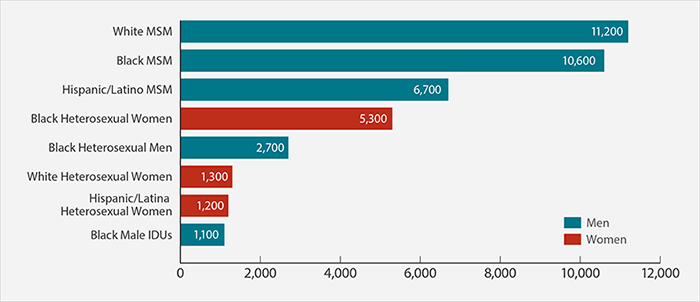Gay, bisexual, and other men who have sex with men (MSMa), particularly young black/African American MSM, are most seriously affected by HIV.
By race, blacks/African Americans face the most severe burden of HIV.
CDC estimates that 1,218,400 persons aged 13 years and older are living with HIV infection, including 156,300 (12.8%) who are unaware of their infection. Over the past decade, the number of people living with HIV has increased, while the annual number of new HIV infections has remained relatively stable. Still, the pace of new infections continues at far too high a level—particularly among certain groups.
HIV Incidence (new infections): The estimated incidence of HIV has remained stable overall in recent years, at about 50,000 new HIV infections per year. Within the overall estimates, however, some groups are affected more than others. MSM continue to bear the greatest burden of HIV infection, and among races/ethnicities, African Americans continue to be disproportionately affected.
HIV Diagnoses (new diagnoses, regardless of when infection occurred or stage of disease at diagnosis): In 2013, an estimated 47,352 people were diagnosed with HIV infection in the United States. In that same year, an estimated 26,688 people were diagnosed with AIDS. Overall, an estimated 1,194,039 people in the United States have been diagnosed with AIDS.
Deaths: An estimated 13,712 people with an AIDS diagnosis died in 2012, and approximately 658,507 people in the United States with an AIDS diagnosis have died overall. The deaths of persons with an AIDS diagnosis can be due to any cause—that is, the death may or may not be related to AIDS.
By Risk Group
Gay, bisexual, and other men who have sex with men (MSM) of all races and ethnicities remain the population most profoundly affected by HIV.
In 2010, the estimated number of new HIV infections among MSM was 29,800, a significant 12% increase from the 26,700 new infections among MSM in 2008.
Although MSM represent about 4% of the male population in the United States, in 2010, MSM accounted for 78% of new HIV infections among males and 63% of all new infections. MSM accounted for 54% of all people living with HIV infection in 2011, the most recent year these data are available.
In 2010, white MSM continued to account for the largest number of new HIV infections (11,200), by transmission category, followed closely by black MSM (10,600).
The estimated number of new HIV infections was greatest among MSM in the youngest age group. In 2010, the greatest number of new HIV infections (4,800) among MSM occurred in young black/African American MSM aged 13–24. Young black MSM accounted for 45% of new HIV infections among black MSM and 55% of new HIV infections among young MSM overall.
Since the epidemic began, an estimated 311,087 MSM with an AIDS diagnosis have died, including an estimated 5,380 in 2012.
Figure 1: Estimated New HIV Infections in the United States, 2010, for the Most Affected Subpopulations

Source: CDC. Estimated HIV incidence among adults and adolescents in the United States, 2007–2010. HIV
Surveillance Supplemental Report 2012;17(4). Subpopulations representing 2% or less are not reflected in thischart. Abbreviations: MSM, men who have sex with men; IDU, injection drug user.
*Subpopulations representing 2% or less are not reflected in this chart. Abbreviations: MSM, men who have sex with men; IDU, injection drug user.
Heterosexuals and injection drug users also continue to be affected by HIV.
Since the epidemic began, almost 92,613 persons with AIDS that were infected through heterosexual sex, have died, including an estimated 4,550 in 2012.
New HIV infections among women are primarily attributed to heterosexual contact (84% in 2010) or injection drug use (16% in 2010). Women accounted for 20% of estimated new HIV infections in 2010 and 23% of those living with HIV infection in 2011. The 9,500 new infections among women in 2010 reflect a significant 21% decrease from the 12,000 new infections that occurred among this group in 2008.
Injection drug users represented 8% of new HIV infections in 2010 and 15% of those living with HIV in 2011.
Since the epidemic began, nearly 186,728 people with (AIDS) who inject drugs have died, including an estimated 3,514 in 2012.
By Race/Ethnicity
Blacks/African Americans continue to experience the most severe burden of HIV, compared with other races and ethnicities.
Blacks represent approximately 12% of the U.S. population, but accounted for an estimated 44% of new HIV infections in 2010. They also accounted for 41% of people living with HIV infection in 2011.
Since the epidemic began, an estimated 270,726 blacks with AIDS have died, including an estimated 6,540 in 2012.
Hispanics/Latinos are also disproportionately affected by HIV.
Hispanics/Latinos represented 16% of the population but accounted for 21% of new HIV infections in 2010. Hispanics/Latinos accounted for 20% of people living with HIV infection in 2011.
Disparities persist in the estimated rate of new HIV infections in Hispanics/Latinos. In 2010, the rate of new HIV infections for Latino males was 2.9 times that for white males, and the rate of new infections for Latinas was 4.2 times that for white females.
Since the epidemic began, more than 100,888 Hispanics/Latinos with an AIDS diagnosis have died, including 2,155 in 2012.
For assessing disease risk, the term MSM is often used instead of gay, homosexual, or bisexual because it refers to a risk behavior, rather than an identity that may or may not be tied to a behavior.
National Center for HIV/AIDS, Viral Hepatitis, STD, and TB Prevention Division of HIV/AIDS Prevention.